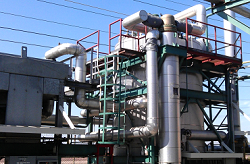 Using low-grade, waste feed oils for biodiesel production might look appealing on the surface, but those feedstocks contain high levels of free fatty acids (FFA), which can cause soap formation. This article in Biodiesel Magazine gives a good, in-depth look at using glycerolysis as a cost-saving alternative to traditional methods of biodiesel production.
Using low-grade, waste feed oils for biodiesel production might look appealing on the surface, but those feedstocks contain high levels of free fatty acids (FFA), which can cause soap formation. This article in Biodiesel Magazine gives a good, in-depth look at using glycerolysis as a cost-saving alternative to traditional methods of biodiesel production.
[G]lycerolysis reduces the amount of FFA in low-grade oils without use of acid or methanol, and enables them to be converted into final product, rather than removing them and reducing product yield. The resulting glycerides formed during glycerolysis are then converted directly to biodiesel via base-catalyzed transesterification. Also, glycerolysis is done at high enough temperatures to completely dry the feed oil before the transesterification process, thus avoiding the formation of excess soaps and the decanting problems that can result.
Over the past decade, glycerolysis has continued to grow in popularity among those companies successful in the industry. For example, recent articles in several industry periodicals have noted that some biodiesel producers have been using glycerolysis successfully for several years (e.g., Renewable Energy Group’s Seneca, Ill., plant).
The rate of the glycerolysis reaction is determined by two variables: the initial concentration of FFA and temperature. Many biodiesel plants run their processes using steam heating systems, and are limited to operating temperatures of 350 degrees Fahrenheit or less. Although glycerolysis can be run at these lower temperatures, reaction kinetics are vastly improved when run at temperatures at or above 450 F. However, operating temperatures approaching 500 F are not recommended due to possible glycerin decomposition, forming acrolein.
The article goes on to say that the lack of use of this high-temperature process might be more a matter of inexperience by biodiesel producers. But the authors believe the actual simplicity of the glycerolysis process could be its most appealing feature.

